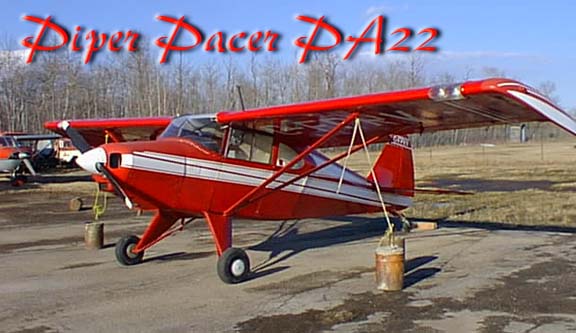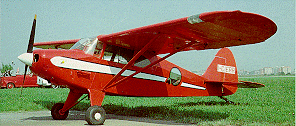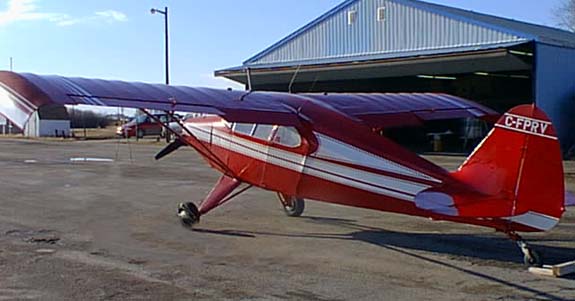
 Everyone knows
about the Piper Cub, greatest little aircraft ever, economical, durable and uncomplicated
to fly. In Canada's North and bushed areas the most common wings in the sky besides
ducks are those of Piper's Super Cub the PA-18. But, the tandem Cubs lead to a whole
series of side by side aircraft in the late forties and early fifties for general
aviation. All of them look pretty similar and are made the same way with a steel
tube airframe covered with fabric and fabric covered metal formed wings. The first
side by side Piper was the J-4 cub a modest two seat affair then came the PA-15 Vagabond
in 1948, first as a 65 hp two seater, then the 4 seat PA -16 Clipper, this name was
to go with the aircrafts short wing, but had to go because Pan American owned the
name. The Cubs with their longer wings continued to be made with three seat J-5 and
the PA-12 versions, then came the work horse PA-18 Super Cub.
Everyone knows
about the Piper Cub, greatest little aircraft ever, economical, durable and uncomplicated
to fly. In Canada's North and bushed areas the most common wings in the sky besides
ducks are those of Piper's Super Cub the PA-18. But, the tandem Cubs lead to a whole
series of side by side aircraft in the late forties and early fifties for general
aviation. All of them look pretty similar and are made the same way with a steel
tube airframe covered with fabric and fabric covered metal formed wings. The first
side by side Piper was the J-4 cub a modest two seat affair then came the PA-15 Vagabond
in 1948, first as a 65 hp two seater, then the 4 seat PA -16 Clipper, this name was
to go with the aircrafts short wing, but had to go because Pan American owned the
name. The Cubs with their longer wings continued to be made with three seat J-5 and
the PA-12 versions, then came the work horse PA-18 Super Cub. In 1950 Piper introduced the PA-20 Pacer which was similar
This example shown on this page was made in 1953 and imported into Canada in 1964. Fox Trot, Papa, Romeo, Victor has been owned by James Reichert of Saskatoon for the past twelve years and is by far the most common of the Tri-Pacers fitted with a 135hp Lycoming. There were also 150hp and 160hp versions of this same aircraft which was manufactured up until 1960.

 Like the one shown on the right (which
is for sale and if you click on it will lead you to a Italian web site) Mr. Reichert's
Tri-Pacer has been converted to a conventional geared Pacer. This aircraft has also
had large drooping wing tips added which are intended to improve low speed performance,
some pilot even claim improved cruise performance with this modification.
Like the one shown on the right (which
is for sale and if you click on it will lead you to a Italian web site) Mr. Reichert's
Tri-Pacer has been converted to a conventional geared Pacer. This aircraft has also
had large drooping wing tips added which are intended to improve low speed performance,
some pilot even claim improved cruise performance with this modification.The Tri-Pacer is a remarkable aircraft with performance that matches or exceeds that of its contemporary all metal Cessna 172. It is a full seven feet shorter in length then a 172 and takes off in a shorter distance with a higher cruise speed. A Tri-Pacer can take off with a gross weight of 1,950 pounds and since its empty wieght is 1,060 this gives it a useful load of 890 pounds of people and fuel. However FPRV is only 885 pounds empty making it almost an ultra-light, so its useful load is a full 1,065 pounds. The wings appear to be stubby but they are actually 29 feet and have 147.5 square feet of lifting capacity. The Tri-Pacer is a little short on cargo handling as it can only have 50 pounds of luggage and its short 570 mile cruise range is the result of its small 36 US gallon fuel tanks.
Where the Tri-Pacer wins over its pilots is with its performance and the delight it is to fly an aircraft that can get airborne fully loaded in 1,220 feet and land over a 50 foot barrier in 1,280 feet. It stalls at 48 mph and best rate of climb is at 84 mph when it can get 620 feet per minute. At 7,000 and 75% power it will true out at 132 mph and its service ceiling is 15,000.
